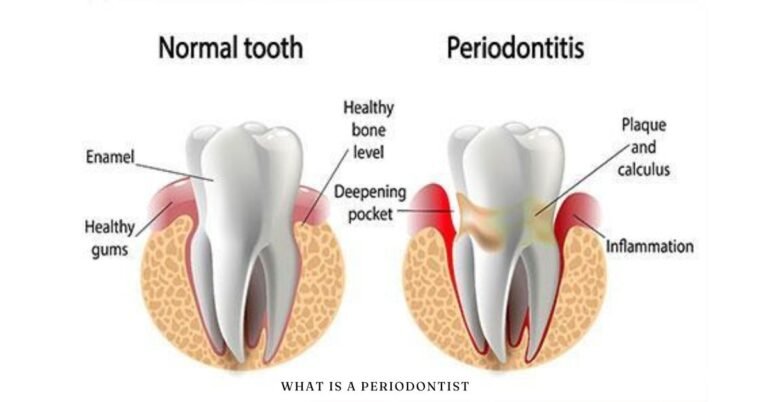Maintaining excellent oral hygiene is essential not only for a bright smile but also for overall health. While general dentists help with routine dental care like cleaning, fillings, and cavities, sometimes you need specialized care that goes beyond these basics. This is where periodontists come into the picture. If you’re wondering what is a periodontist and how they can assist you, this comprehensive guide will break down everything you need to know.
From gum disease treatment to dental implants, periodontists play a critical role in advanced oral health care. In this article, we’ll explore who periodontists are, what they do, when you need to see one, and how their expertise differs from that of a general dentist.
Who Is a Periodontist?
A periodontist is a dental specialist with advanced training in the prevention, diagnosis, and treatment of periodontal (gum) diseases. They also specialize in the placement of dental implants and are experts in managing the soft and hard tissues in the mouth. Essentially, a periodontist focuses on all aspects of gum health, which is the foundation of your teeth.
Periodontists are required to complete dental school just like general dentists, but their training doesn’t stop there. After earning a dental degree, they must undergo three additional years of specialized education in periodontology. During this time, they gain in-depth knowledge about gum disease, oral inflammation, surgical procedures, and techniques for restoring oral health.
Their expertise extends beyond treating visible gum issues. They delve into systemic factors, such as how diabetes, smoking, and genetic predispositions impact periodontal health. Many periodontists also use cutting-edge technology like laser treatments and regenerative techniques to provide the most effective care.
Related terms like “gum specialist” or “implant dentist” are often used interchangeably with periodontists, but their scope is broader than what these labels might suggest.
What Does a Periodontist Do?
The work of a periodontist encompasses a wide range of services, all aimed at promoting optimal gum and bone health. Here’s an in-depth look at their primary responsibilities:
1. Diagnosing and Treating Gum Disease
Gum disease, also known as periodontal disease, is one of the leading causes of tooth loss in adults. Periodontists treat both mild cases, like gingivitis, and more severe cases, such as periodontitis. They use various methods, including scaling and root planing (a deep-cleaning procedure) and antibiotic therapies, to manage the condition.
In advanced cases, periodontists may perform surgeries like flap surgery or gum grafts to restore gum health and prevent further bone loss. Their goal is not just to treat the disease but also to prevent its recurrence by addressing the underlying causes.
2. Placing Dental Implants
One of the most advanced services provided by periodontists is dental implant placement. This procedure involves inserting a titanium post into the jawbone to replace missing teeth. The success of a dental implant depends largely on healthy gums and sufficient bone support, both of which are within a periodontist’s area of expertise.
Periodontists carefully evaluate the health of the gums and jawbone before performing the implant procedure. They may also recommend bone grafting to strengthen the area if necessary. Their specialized training ensures that the implants are placed accurately for long-term stability and functionality.
3. Cosmetic Gum Procedures
Beyond treating gum disease, periodontists can enhance the appearance of your smile through cosmetic procedures. These include:
- Gum Contouring: Adjusting the gum line to create a balanced and symmetrical smile.
- Crown Lengthening: Exposing more of the tooth structure for restorative or aesthetic purposes.
- Gum Grafting: Restoring receded gums to improve the appearance and protect the roots of the teeth.
These procedures not only boost confidence but also promote better oral health.
When Should You See a Periodontist?
Not everyone needs to visit a periodontist regularly, but there are specific situations where their expertise is invaluable. Here are some signs and scenarios where you should consider seeing a periodontist:
1. Persistent Gum Problems
If you notice symptoms like red, swollen, or bleeding gums that don’t improve with routine care, it could be a sign of gum disease. Periodontists are equipped to handle complex gum issues that general dentists may not have the tools or training to address.
2. Receding Gums
Receding gums expose the roots of your teeth, making them more susceptible to decay and sensitivity. Periodontists can perform gum grafting procedures to protect the roots and restore the gum line.
3. Loose Teeth or Jawbone Issues
Gum disease can lead to bone loss, which in turn causes teeth to become loose. A periodontist can assess the extent of the damage and recommend treatments to stabilize your teeth and preserve bone structure.
4. Preparing for Dental Implants
If you’re considering dental implants, a periodontist is the best professional to consult. Their expertise ensures that the procedure is done safely and successfully.
5. Aesthetic Concerns
For those looking to improve the appearance of their smile, periodontists offer a range of cosmetic treatments. Whether you want to correct a gummy smile or address uneven gum lines, they can provide tailored solutions.
Periodontist vs. Dentist: What’s the Difference?
It’s common to wonder how a periodontist differs from a general dentist. While both play vital roles in oral health, their areas of focus and expertise vary significantly.
| Aspect | General Dentist | Periodontist |
|---|---|---|
| Scope | Routine dental care, including cleanings, fillings, and crowns. | Specializes in gum health, periodontal disease, and dental implants. |
| Training | 4 years of dental school. | 4 years of dental school + 3 years of specialty training. |
| Procedures | Focus on teeth, cavities, and basic gum care. | Advanced gum treatments, surgeries, and implant placement. |
| When to Visit | Regular check-ups and preventive care. | Complex gum issues, advanced surgeries, and cosmetic gum treatments. |
Understanding these differences can help you decide which professional to consult for your specific needs.
How Do Periodontists Treat Gum Disease?
The approach a periodontist takes to treat gum disease depends on the severity of the condition. Here’s a breakdown of common treatments:
1. Non-Surgical Treatments
For early-stage gum disease (gingivitis), non-surgical treatments like scaling and root planing may suffice. This procedure removes plaque and tartar from below the gum line and smoothens the roots to prevent bacteria from reattaching.
Additionally, periodontists may prescribe topical or oral antibiotics to reduce bacterial infection.
2. Surgical Treatments
For more advanced cases, surgery may be required. Common surgical procedures include:
- Flap Surgery: Removing bacteria and tartar from deep pockets by lifting the gums.
- Bone Grafting: Rebuilding lost bone using natural or synthetic graft materials.
- Gum Grafting: Restoring lost gum tissue to protect teeth and enhance aesthetics.
3. Laser Therapy
Some periodontists use laser technology as a less invasive alternative to traditional gum surgery. Laser treatments are precise, reduce discomfort, and promote faster healing.
These treatments are customized based on the patient’s needs, ensuring the best possible outcomes.
The Importance of Healthy Gums
Your gums play a vital role in your oral and overall health. Healthy gums act as a protective barrier against bacteria and provide essential support to your teeth. Neglecting gum health can lead to serious consequences, including tooth loss, bone deterioration, and systemic health issues.
Research has shown a strong connection between periodontal disease and conditions like heart disease, diabetes, and respiratory issues. Periodontists not only treat gum disease but also educate patients on maintaining optimal gum health through proper oral hygiene practices.
Conclusion
A periodontist plays a crucial role in maintaining and restoring gum health, which is foundational to your overall oral well-being. From treating gum disease to performing advanced procedures like dental implants and cosmetic gum surgeries, their expertise is indispensable for complex oral health needs.
If you’re experiencing persistent gum issues, considering dental implants, or seeking to improve the aesthetics of your smile, consulting a periodontist can make a world of difference. Prioritize your gum health and don’t hesitate to seek specialized care when needed—your smile and overall health depend on it!
FAQs About Periodontists
1. What is the difference between a periodontist and an orthodontist?
While periodontists focus on gum health and dental implants, orthodontists specialize in aligning teeth and jaws using braces or clear aligners.
2. How often should I see a periodontist?
It depends on your oral health. If you have a history of gum disease, regular visits every 3–6 months may be necessary. Otherwise, consult your dentist to determine if you need to see a periodontist.
3. Are periodontist treatments covered by insurance?
Most dental insurance plans cover periodontal treatments, but coverage varies. It’s best to check with your provider for specific details.
4. Can gum disease be reversed?
Early-stage gum disease (gingivitis) can often be reversed with professional cleaning and improved oral hygiene. Advanced stages (periodontitis) require specialized treatment to manage the condition.

